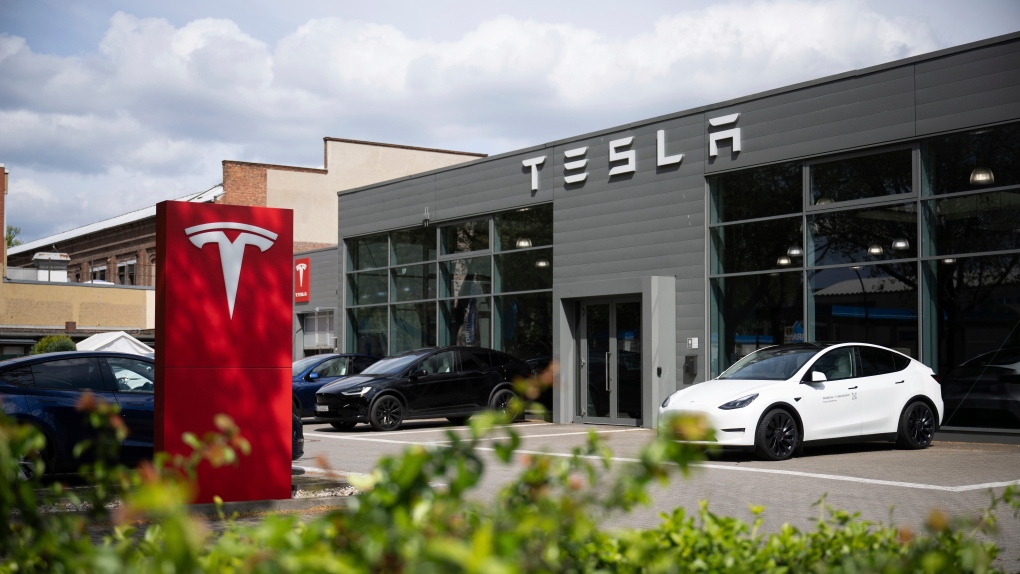Tesla’s first-quarter net income plummeted 55 per cent as falling global sales and price cuts sliced into the electric vehicle maker’s revenue and profit margins.
The Austin, Texas, company said it made US$1.13 billion from January through March compared with $2.51 billion in the same period a year ago.
Revenue was $21.3 billion, down nine per cent from last year as worldwide sales dropped nearly nine per cent due to increased competition and slowing demand for electric vehicles. Tesla also blamed an arson attack at its German plant and factory downtime as it switched factories to an updated version of the Model 3 sedan.
Excluding one-time items such as stock-based compensation, Tesla made 45 cents per share, falling short of analyst estimates of 49 cents, according to FactSet.
The company’s gross profit margin, the percentage of revenue it gets to keep after expenses, fell once again to 17.4 per cent. A year ago it was 19.3 per cent, and it peaked at 29.1 per cent in the first quarter of 2022.
Tesla said in a letter to investors Tuesday that its vehicle sales growth “may be notably lower” than last year as it works on the launch of its next generation vehicle and unidentified other products.
The next generation vehicle apparently is the small Model 2, which is expected to cost around $25,000 and give Tesla more appeal to mass-market buyers. It wasn’t clear whether the company would continue to pursue that car.
The company also appears to be counting on a vehicle built to be a fully autonomous robotaxi as the catalyst for future earnings growth. CEO Elon Musk has said the robotaxi will be unveiled on Aug. 8.
Shares of Tesla rose 5.2 per cent in trading after Tuesday’s closing bell, but they are down more than 40 per cent this year. The S&P 500 index is up about five per cent.
Investors and analysts will be looking for more specific answers from Musk on an earnings conference call later Tuesday. Many analysts say the sales decline raises questions about demand for Teslas and other electric vehicles.
Musk has been touting the robotaxi as a growth catalyst for Tesla since the hardware for it went on sale late in 2015. He has called the system “Full Self Driving,” even though the company says on its website that it can’t drive itself and humans must be ready to take control at all times.
In 2019, Musk promised a fleet of autonomous robotaxis by 2020 that would bring income to Tesla owners and make their car values appreciate. Instead, they’ve declined with price cuts, as the autonomous robotaxis have been delayed year after year while being tested by owners as the company gathers road data for its computers.
Industry analysts are skeptical, and feared that Musk has cancelled or delayed plans for the Model 2.
Over the weekend, Tesla lopped $2,000 off the price of the Models Y, S and X in the U.S. and reportedly made cuts in other countries including China. It also slashed the cost of “Full Self Driving” by one third to $8,000.
In a note to investors Monday, Bank of America Global Research analyst John Murphy wrote that Tesla’s shares have been under pressure since the start of the year due to weaker EV sales, and production that exceeds demand.
“We retain some level of skepticism on Tesla’s growth prospects, but also see opportunities as the company will unveil future growth drivers (robotaxi and Model 2) in the coming months,” Murphy wrote, adding that he maintains a neutral rating on the stock.
On Sunday, Musk wrote on X, the social media platform he owns, that like other automakers, Tesla prices change frequently “in order to match production with demand.”
From January through March, Tesla manufactured 433,371 vehicles and delivered 386,810, making over 46,000 more than it sold. This even after it cut prices last year on some of its more expensive models by up to $20,000.
Last week Tesla announced it would cut 10 per cent of its 140,000 employees, and key executive Andrew Baglino, senior vice president of powertrain and energy engineering, announced he was leaving after 18 years. The company also announced that it would ask shareholders to restore a $56 billion pay package for Musk that was rejected by a Delaware court.
Murphy wrote that on Tuesday, he expects Musk and the company to give some hints about the robotaxi, and also could reiterate an intent to start making the Model 2 in 2025 or 2026.
For years, Musk has told owners and investors that Teslas with “Full Self Driving” software and hardware will be able to drive themselves and could earn money carrying passengers when they normally would have been parked.
But “Full Self Driving” thus far has not been anything other than a partially automated driver assist system that can’t drive itself.
Early last year the National Highway Traffic Safety Administration made Tesla recall its “Full Self-Driving” system because it can misbehave around intersections and doesn’t always follow speed limits. Tesla’s less-sophisticated Autopilot system also was recalled to bolster its driver monitoring system.
Some experts, though, don’t think any system that relies solely on cameras like Tesla’s can ever reach full autonomy.

